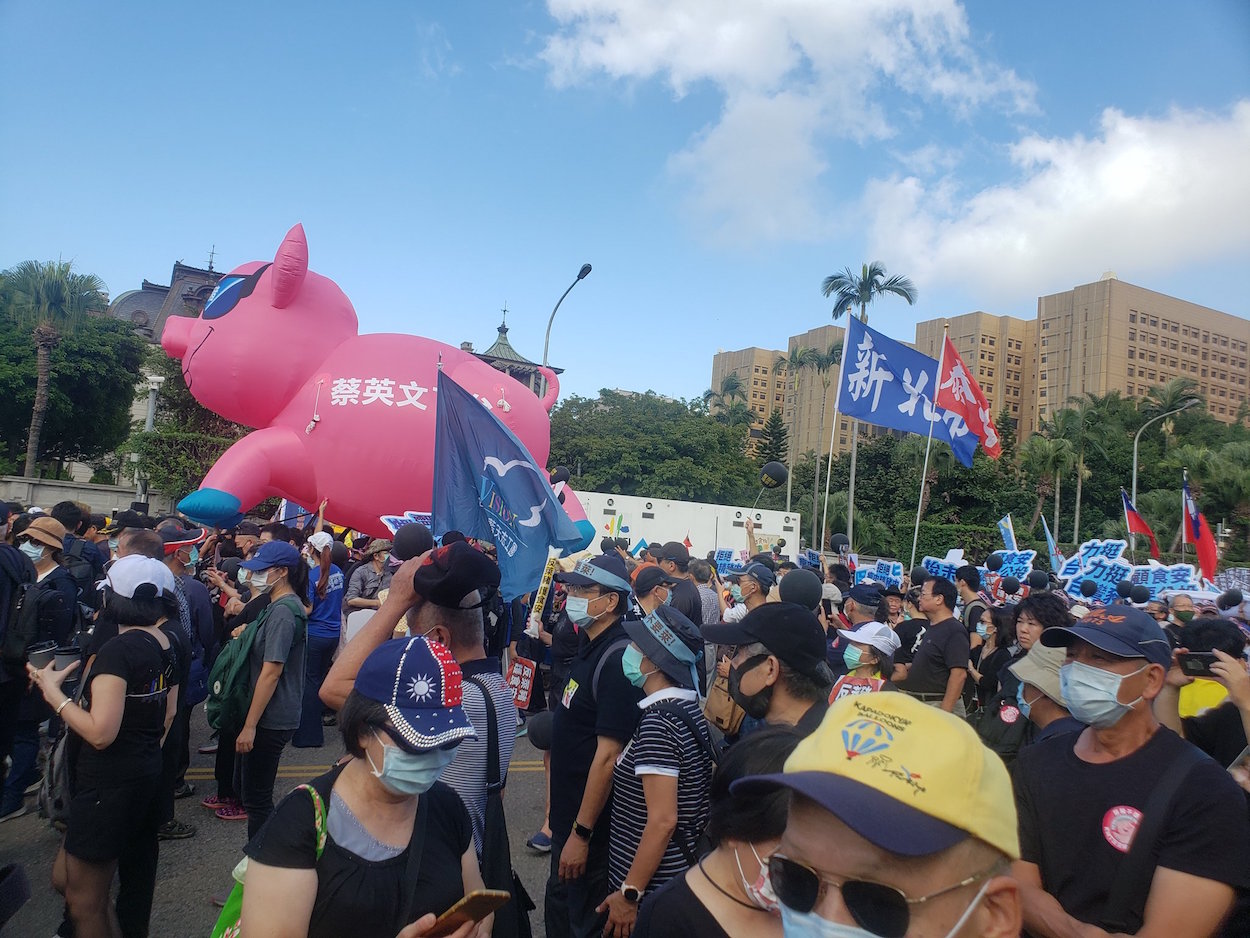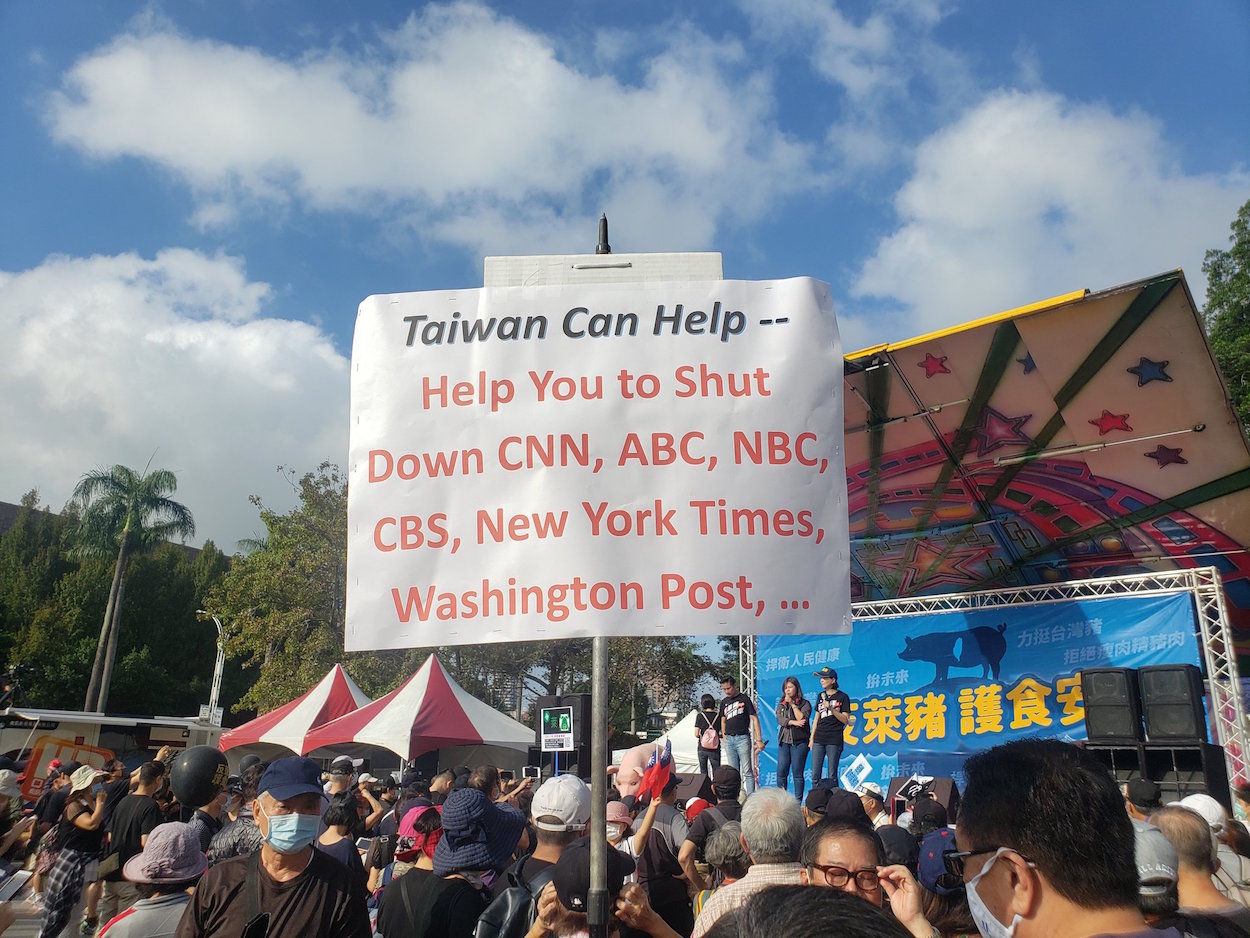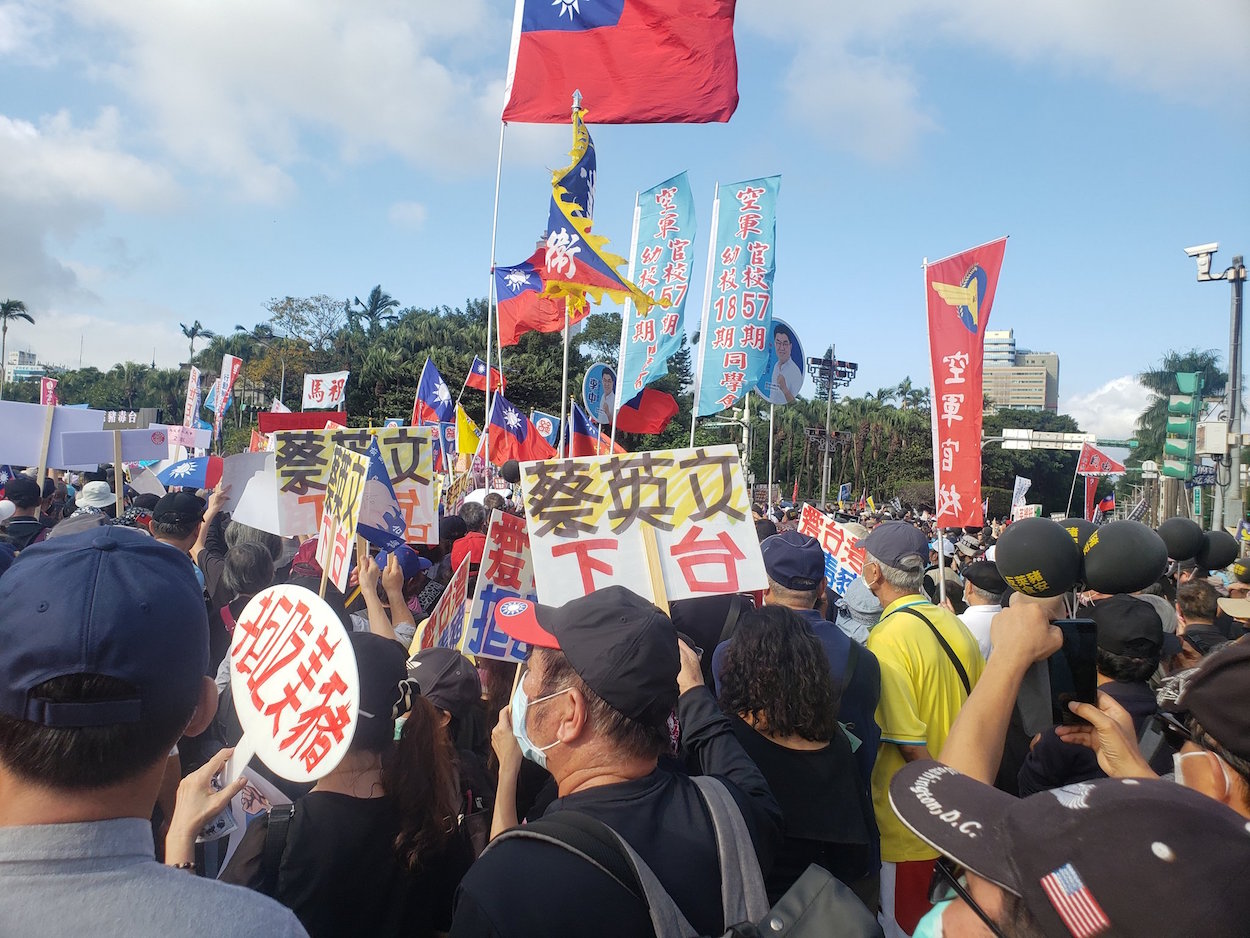by Brian Hioe
語言:
English
Photo Credit: Lev Nachman
THE ANNUAL Autumn Struggle labor demonstration was held yesterday in Taipei. Autumn Struggle is traditionally one of the major labor demonstrations in Taiwan, along with International Workers’ Day on May 1st. Despite the name, it is not unusual for Autumn Struggle to take place during what is actually winter. However, this year’s demonstration saw significant controversy due to the perceived co-optation of the event by the KMT, with the event centering around the demand to prevent ractopamine-treated pork imports from the US this year, rather than more traditional labor demands. Organizers claimed that over 50,000 participated in the demonstration, with a march moving from Ketagalan Boulevard to DPP headquarters.
In past years, Autumn Struggle has seen declining attendance, resulting in 2018’s event being the smallest Autumn Struggle in the thirty-year history of the event. Autumn Struggle was not held in 2019, due to internal splits regarding the upcoming presidential election, after the KMT’s unexpected resurgence in 2018 local elections led it to seem as if the DPP faced a serious threat in 2020 presidential elections. International Workers’ Day commemorations earlier this year also did not take place, due to concerns regarding the ongoing COVID-19 pandemic.
 Photo credit: Lev Nachman
Photo credit: Lev Nachman
That being said, in the first two years of the Tsai administration, the labor movement in Taiwan saw an uptick of activity. This was due to heated protests against labor reforms passed by the Tsai administration that undid thirty years of labor reforms and because of a wave of union activity in the transportation industry, particularly the airline industry. The subsequent decline in union activity likely also reflects exhaustion and burnout after a high point of activity. Ironically, protests against the Tsai administration’s changes to the Labor Standards Act individuals that later became DPP legislators or party officials, in addition to saw significant participation from the NPP.
Yet controversy regarding this year’s Autumn Struggle began before the event itself, with labor activists reacting against what they viewed as a betrayal of Autumn Struggle’s historic emphasis on steering clear of political parties and seeking to be critical of both the pan-Green and pan-Blue camp alike. Other activists, such as Chen Hsiulien of the Taiwan International Workers’ Association, took a stance in support of still participating in the event. Political contestation regarding Autumn Struggle is complicated by the fact that the pro-unification left, which views China as a socialist workers’ utopia, has always had a presence in the labor movement, including individuals that later joined KMT administrations.
For this year’s Autumn Struggle, though politicians were still prevented from speaking on the main stage, the KMT and TPP set up stages at Liberty Plaza and the Chiang Kai-Shek Memorial MRT station. Among those to participate in Autumn Struggle were KMT chair Johnny Chiang, former president Ma Ying-jeou, former New Taipei mayor Eric Chu, and former KMT chair Wu Den-yih. TPP chair and Taipei mayor Ko Wen-je did not participate, stating that as mayor, he had to be politically neutral, but that he supported the event. The official organizers of the event stated that the event had three contingents, one of which was focused on food safety and labor protections, the second on environmental issues and education, and the third on freedom of speech and land issues.
Demonstrators wore black. Demographically, this year’s Autumn Struggle saw a comparative lack of visible traditional union groups, with a greater number of demonstrators carrying banners with pan-Blue slogans and talking points. Many carried signs protesting the National Communication Commission’s decision not to renew the license of television network CtiTV for its repeated violations of the broadcasting regulations. CtiTV is owned by the Want Want Group, a conglomerate that owns not only CtiTV, but also the China Times, and CTV. The Want Want Group has been reported as having accepted Chinese funding and taken direct orders from China’s Taiwan Affairs Office by the Financial Times and Apple Daily. The Want Want Group’s owner, Tsai Eng-meng, one of Taiwan’s richest men, has been open about his aim is to promote positive views of China in Taiwan, in order to push Taiwan toward unification with China. Tsai was also present at the protest, with demonstrators carrying banners decrying the “death of freedom of speech” in Taiwan and claiming that the Tsai administration was a “party-state”.
 Photo credit: Lev Nachman
Photo credit: Lev Nachman
After the event, pan-Blue outlets such as the United Daily News are trumpeting Autumn Struggle this year as the largest-ever Autumn Struggle in the history of the event.
The Tsai administration lifted the ban on ractopamine-treated pork imports in September in an effort to secure a bilateral trade agreement with the US. This is in the hopes that closer economic relations between the US and Taiwan will strengthen the political incentive for America to defend Taiwan. Taiwan’s ban on imports of ractopamine-treated meat has long been a stumbling block to a trade agreement between the US and China.
Critics have raised the danger to Taiwanese consumers, seeing as ractopamine-treated meat is banned in 160 of the 200 or so countries in the world while the Tsai administration has highlighted that Taiwanese consumers would not necessarily have to purchase ractopamine-treated pork, but could still purchase Taiwanese pork. Taiwanese pig farmers were also among those to react against the lifting of the ban, with farmers among those most severely affected by Taiwan’s entrance into international free trade agreements as well as the World Trade Organization.
But one notes that this anti-free trade framing was not emphasized by pan-Blue participants of the demonstration, with the Tsai administration instead targeted as violating freedoms of speech and endangering the food safety of Taiwanese citizens. The KMT currently intends to push for a national referendum on ractopamine-treated pork.
Indeed, it strikes as odd for a labor protest to include Taiwan’s second richest man, Tsai Eng-meng, as well as KMT politicians that have historically pushed for free trade agreements such as Ma to be part of the protest. Apart from advancing the CSSTA, which was to be signed with China, Ma also currently advocates Taiwan joining the RCEP and TPP. To this extent, during its tenure in power, the Ma administration sought to lift the ban on ractopamine-treated pork imports, while it was the DPP that opposed the lifting of the ban. The DPP and KMT have traded positions on the issue of ractopamine-treated meat between when they were in power and as the opposition. The DPP has criticized the KMT as disseminating fake news to stir up fears regarding ractopamine.
 Photo credit: Lev Nachman
Photo credit: Lev Nachman
Some labor groups were critical of Ma’s participation in the demonstration, with the Taoyuan City Trade Union criticizing the Ma administration’s actions toward labor during its years in power. Nevertheless, one expects the large pan-Blue showing at Autumn Struggle to further existing splits within Taiwan’s labor movement, as well as raise questions in the labor movement regarding how to relate to ruling and opposition parties.
The pan-Blue camp may also try to emphasize appeals to Taiwanese labor going forward. KMT party traditionalists sometimes try to emphasize what they frame as a positive relation of the KMT and labor unions during the authoritarian period. This is despite that labor unions served as a system of control for the KMT during the authoritarian period, leading to the formation of the Taiwan Confederation of Trade Unions, which was closer to the DPP, as a counter to the KMT-affiliated Chinese Federation of Labor. Efforts to co-opt Taiwanese labor by leading KMT politicians include former chair Hung Hsiu-chu paying a visit to the China Airlines flight attendants’ strike in 2016 and outreach to demonstrators protesting the Tsai administration’s changes to the Labor Standards Act. The KMT may step up such efforts.

